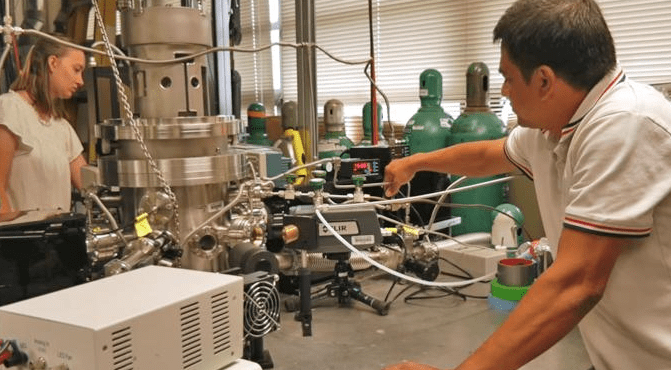HONOLULU (KHON2) — A team from the University of Hawaii at Manoa is diving into a major climate challenge—rethinking the refrigerants used in everything from air conditioning to food preservation.
On August 21, the National Science Foundation (NSF) announced that UH Manoa, alongside five other universities, will share a $26 million grant to launch a new generation (Gen-4) NSF Engineering Research Center (ERC) focused on developing sustainable refrigerant technology.
Common refrigerants, known as hydrofluorocarbons (HFCs), are widely used in heating, ventilation, air conditioning, and refrigeration systems (HVACR). However, these systems are responsible for nearly 10% of global greenhouse gas emissions due to HFC leaks and the high energy needed to operate them.
The new ERC, named Environmentally Applied Refrigerant Technology Hub (EARTH), aims to transform the refrigerant lifecycle. The goal is to reduce HFC emissions, develop safer replacement refrigerants, and enhance the energy efficiency of HVACR systems.
“Understanding the underlying chemistry of new refrigerants in the atmosphere is central to defining the impact on our climate and ultimately the rise of sea levels,” said UH Mānoa Professor Ralf I. Kaiser, the project lead from the Department of Chemistry. “We will be developing a tightly integrated collaborative network to predict for the first time the atmospheric impact of potential new refrigerants before they are incorporated into HVACR systems. This is just one aspect of UH’s role in this important project.”
Joining UH Manoa in this effort are teams from the University of Notre Dame, Lehigh University, University of South Dakota, University of Maryland, and project lead University of Kansas.
They were selected from hundreds of proposals following a rigorous two-year review process. The NSF currently supports just 15 ERCs in fields like advanced manufacturing, energy, environment, health, and infrastructure.
“For UH to be part of a team selected for an NSF Engineering Research Center speaks volumes about the quality of our researchers and personnel,” said UH Mānoa Provost Michael Bruno. “This groundbreaking project positions UH at the forefront of climate change mitigation while addressing a critical challenge to Hawaiʻi and the world.”
NSF Director Sethuraman Panchanathan highlighted the importance of ERCs in tackling big challenges.
“NSF Engineering Research Centers are powerhouses of discovery and innovation, bringing America’s great engineering minds to bear on our toughest challenges,” Panchanathan said. “By collaborating with industry and training the workforce of the future, ERCs create an innovation ecosystem that can accelerate engineering innovations, producing tremendous economic and societal benefits for the nation.”
The UH Manoa team includes Professors Kaiser, Rui Sun, Christina Karamperidou, Kieko Matteson, and Jennifer Pagala Barnett. Kaiser believes UH’s role in the project is fitting given Hawaii’s vulnerability to climate change.
“Hawaii is increasingly vulnerable to global warming and its impacts, including more frequent and severe weather extremes and sea level rise,” Kaiser said. “Sea level rise, which exacerbates flooding, coastal inundation, and erosion, poses a serious threat not only to Hawaii but also to major population centers along the Pacific Rim, such as Japan and Australia.”
Kaiser and Sun’s teams will examine the atmospheric chemistry of refrigerants and their interactions with atmospheric ice particles. Kaiser’s group will use advanced techniques like crossed molecular beams and acoustic levitators, while Sun’s team will employ AI-driven simulations to analyze reactions at the atomic level.
“By following this approach, we will avoid the mistakes done in the 1970s when chlorofluorocarbons (CFCs), an otherwise excellent refrigerant, resulted in catastrophic ozone depletion,” Sun said.
Karamperidou, co-leader of the ERC’s research on safe refrigerants, will integrate experimental and computational data into climate models to understand the impacts of HFCs and their alternatives.
“As temperatures continue to rise and with them the frequency and intensity of heat waves, so does the need for refrigeration and air conditioning,” Karamperidou said. “This leads to increased refrigerant use and related greenhouse gas emissions, creating a vicious cycle that needs to be better understood and ultimately broken.”
Matteson will place the modern demand for cooling into historical context, noting that air conditioning technology first emerged in the early 20th century and became widespread in U.S. homes only in the 1970s.
“Extreme heat is affecting our health, learning, and productivity, and exacerbating disparities between the haves and have-nots,” Matteson said. “Mitigating HFCs’ harmful effects while ensuring everyone can function at a livable temperature is a vital social justice issue that needs to be driven by historical understanding as much as science.”
As part of the center’s work, UH Mānoa will also launch a new interdisciplinary graduate program in atmospheric chemistry to train future leaders in the field.
Barnett will oversee the Diversity and Culture of Inclusion (DCI) for the ERC, focusing on increasing participation from Indigenous and tribal communities.
“I am looking forward to this opportunity to bring our commitment to diversity to our partner universities and to this important effort,” Barnett said. “This is a global issue that we are trying to address, and one of the keys to success is to ensure that all voices are being considered and heard.”
For UH President David Lassner, the project underscores the strength of collaboration across campuses.
“This project demonstrates the amazing synergies we can achieve when our campuses work together,” Lassner said. “Our world-class researchers will be developing solutions to a major global challenge, and we’re also helping our community colleges train the next generation of HVACR professionals.”
The initial $26 million grant is eligible for renewal for an additional five years, extending through 2034. NSF’s ERC program connects industry and universities to strengthen American industry’s competitive edge globally, with components that go beyond research to include workforce development and innovation.
